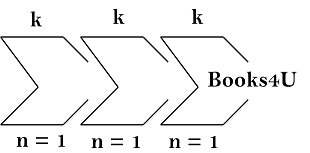RC Phase Shift Oscillator basically consists of an amplifier and a feedback network consisting of resistors and capacitors arranged in ladder fashion. Hence such an oscillator is also called ladder-type RC Phase Shift Oscillator.
To understand the operation of this oscillator let us study RC circuit first, which is used in the feedback network of this oscillator. The Fig. 2.90 shows the basic RC circuit.

The capacitor and resistance
are in series. Now
is the capacitive reactance in ohms given by,
The total impedance of the circuit is,
The r.m.s. value of the input voltage applied is say volts. Hence the current is given by,
From the expression of current, it can be seen that current I leads input voltage by angle
The output voltage is the drop in resistance R given by,
The voltage across the capacitor is,
The drop is in phase with current
while the drop
lags current
by
i.e.
leads
by
. The phasor diagram is shown in the Fig. 2.90 (b).
By using proper values of and
, the angle is adjusted in practice equal to
.
RC Feedback Network
As stated earlier, the RC network is used in the feedback path. In the oscillator, the feedback network must introduce a phase shift of 180° to obtain a total phase shift around a loop as 360°. Thus if one RC network produces a phase shift of 4) = 60° then to produce a phase shift of 180° such three RC networks must be connected in cascade.
Hence in RC phase shift oscillator, the feedback network consists of three RC sections each producing a phase shift of 60°, thus total phase shift due to feedback is 180° (3x 60°). Such a feedback network is shown in Fig. 2.91.
The network is also called the ladder network. All the resistance values and all the capacitance values are the same so that for a particular frequency, each section of R and C produces a phase shift of 60°.
RC Phase Shift Oscillator Using Op-amp
R-C phase shift oscillator using op-amp uses an op-amp in inverting amplifier mode. Thus it introduces the phase shift of 180° between input and output. The feedback network consists of 3 RC sections each producing 60° phase shift. Such an RC phase shift oscillator using op-amp is shown in Fig. 2.92.
The output of the amplifier is given to the feedback network. The output of the feedback network drives the amplifier. The total phase shift around a loop is 180° of the amplifier and 180° due to 3 RC section, thus 360°. This satisfies the required condition for positive feedback and circuit works as an oscillator.

Let us find the transfer function of the RC feedback network :

Applying KVL to various loops we get,

Replacing jω by s and writing the equations in the matrix form,

Using the Crammer’s rule to obtain I3



This is the frequency with which circuit oscillates,
At this frequency,
The negative sign indicates a phase shift of 180°
Now to have the oscillations,
Thus circuit will work as an oscillator which will produce a sinusoidal waveform if the gain is 29 and total phase shift around a loop is 360°. This satisfies the Barkhausen criterion for the oscillator. These oscillators are used over the audio frequency range i.e. about 20 Hz up to 100 kHz.
Advantages
The advantages of R-C phase shift oscillator are,
- The circuit is simple to design.
- Can produce output over the audio frequency range.
- Produces sinusoidal output waveform. –
- It is a fixed-frequency oscillator.
Disadvantages
By changing the values of R and C, the frequency of the oscillator can be changed. But the values of R and C of all three sections must be changed simultaneously to satisfy the oscillating conditions. But this is practically impossible. Hence the phase shift oscillator is considered as a fixed frequency oscillator, for all practical purposes.
And the frequency stability is poor due to the changes in the values of various components, due to the effect of temperature, ageing etc.

Hello there,
thanks for your comprehensive analysis. I think there’s a typo in equation 22 … shouldn’t R be to the third power in the denominator? It’s right in equation 23.
Cheers
LikeLike